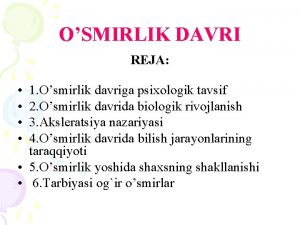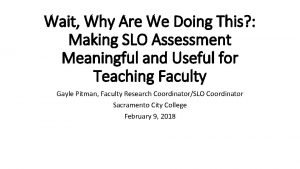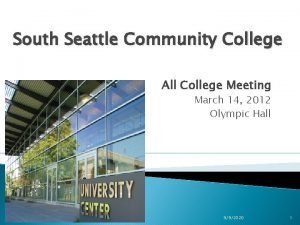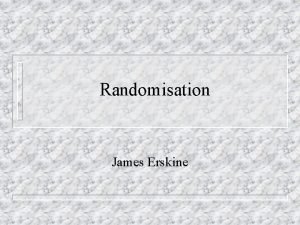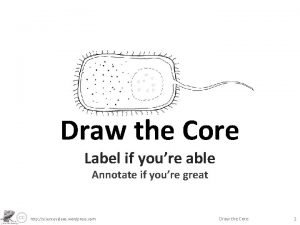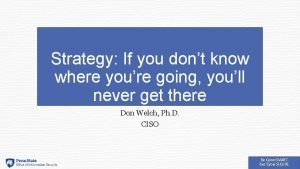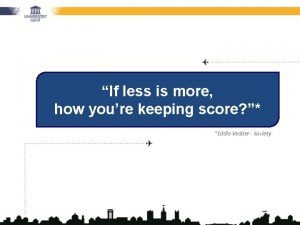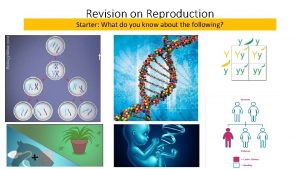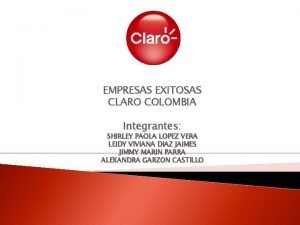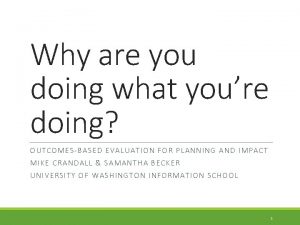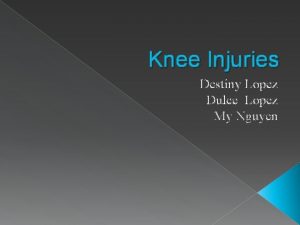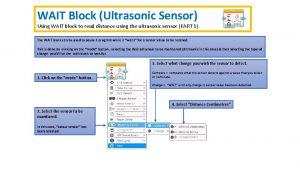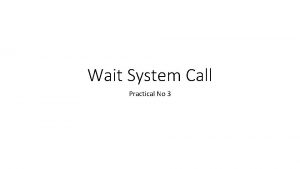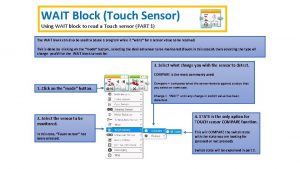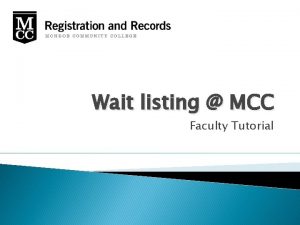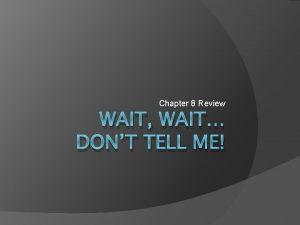WAIT YOURE DOING WHAT Tish Lopez South Seattle





















- Slides: 21

“WAIT, YOU’RE DOING WHAT? ” Tish Lopez, South Seattle College & Ian Sherman and Adie Smith Kleckner, Green River College

Context: Based on feedback from last year’s participants, each convening this year will kick-off with a “feature” session so we can learn and be inspired by the good work and innovations happening right now in our system!

Today’s Session First, we’ll share some new, interesting work happening around ENGL&101 on our campuses! • Assessment: English placement reform at the Seattle Colleges (Tish) • Professional Development: Green River’s One Day Symposiums Ian is sick • Curriculum Innovation: ENGL&101 Interactive Reading Activity (Adie) Afterwards, we’d like to hear from you! What innovative strategies and good work is happening on your campus around ENGL&101? Be prepared to share-out with others at your table!

Innovations in Assessment ENGLISH PLACEMENT REFORM AT THE SEATTLE COLLEGES

English Placement @ the Seattle Colleges: Common Challenges • Our campus over-relies on a high stakes standardized placement test (Wonderlic) which disproportionately places low-income and students of color into pre-college English courses. • We know that phenomenon such as “imposter syndrome” and “stereotype threat” often causes students to doubt their abilities or conform to stereotyped expectations, particularly when it comes to testing and placement. • Significant research states that lengthy developmental sequences are detrimental to students’ path to completion and leads to higher drop-out rates (Bailey & Cho, 2010; Bailey, Jeong & Cho, 2010; Jaggers, Hodara & Stacey, 2013). “Placement is destiny. When students are assessed ‘not college ready, ’ the treatment prescribed–layers of remedial coursework–leaves them less likely to reach their goals. ” – Katie Hern Bailey, Thomas & Cho, Sung-Woo (2010). Developmental Education in Community Colleges. Community College Research Center. New York: CCRC Publications, Columbia University. See also Bailey, T. , Jeong, D. W. , & Cho, S. W. (2010). Referral, enrollment, and completion in developmental education sequences in community colleges. Economics of Education Review, 29(2), 255– 270. See also Jaggars, S. S. , Hodara, M. , & Stacey, G. W. (2013). Designing Meaningful Developmental Reform. Research Overview. Community College Research Center, Columbia University. Katie Hern quote originates from: https: //edsource. org/2015/some-college-students-more-prepared-than-placement-tests-indicate/90418

English Placement @ the Seattle Colleges With one of the most diverse student bodies in the state, equity and inclusion are driving the creation and implementation an equity-based model for placement reform tool at the Seattle Colleges. Our solution? To implementing a shared districtwide Directed Self-Placement (DSP) tool that will provide students with a culturally inclusive and responsive way of placing themselves into the appropriate level English course.

What We’ve Done So Far: Funded through a Perkins Replication Grant in the Spring of 2018, South Seattle College faculty built a small pilot tool for students pursuing a non-academic, professional technical degree (AAS). https: //bit. ly/2 RF 95 O 2

Innovative Features

Incorporating Student Writing Samples as the Primary Guide to Self-Placement Our DSP tool is unique in that students review other student writing samples as part of determining their appropriate course level. Students cite these annotated writing samples as the most helpful element of the DSP tool in their decision on where to place.

Proving a Simplified Framework for all Placement Measures

Current State of Placement @ South Currently, South offers 17 different methods for placement into ENGL&101 Expiration dates between placement methods vary. Furthermore, several methods require students to gather official/unofficial documents and make an appointment with an advisor to verify ENGL&101 eligibility. 17 different placement methods? ! TESTS TRANSCRIPTS OTHER Wonderlic (2 years) HS Transcript (Overall GPA) (10 years) CLEP/PLA SAT (5 years) Bridge to College English (1 year) Placement Reciprocity (1 year) ACT (5 years) College Transcript Instructor Recommendation IELTS (2 years) Grade in previous ENGL course BTS “homegrown” assessment TOEFL (2 years) Grade in previous IEL course GED (10 years) Grade in previous ESL course Smarter Balance (1 year)

Proving a Simplified Framework for all Placement Measures Our DSP tool is the overarching framework for English placement and incorporates all multiple measures, making this DSP tool unique compared to other colleges that have implemented a directed self-placement tool as one option in the suite of multiple measures. When DSP is just one option, students are able to default to other options without exploring self-placement alternatives. By having all students begin with the DSP tool, even if they meet a different multiple measure, students will be more aware of the expectations of each ENGL course.

Providing a Guide for Collaboration Among Separately. Accredited Colleges We are focusing on more than just the creation and implementation of a shared DSP tool; we are also focusing on coding and multiple measures alignment this year to ensure that students are easily able to enroll in courses at any of the Seattle Colleges. All pre-college English courses and College-level English courses are undergoing review and necessary revision to align course descriptions, topical outlines, and learning outcomes. English faculty are conducting meetings with testing, advising, and institutional research to determine how best to code and track DSP data after implementation. Emphasis is on how all three colleges can align the entering and tracking of placement data (using the current SMS or CTClink upgrade scheduled for December 2020). English faculty (in coordination with stakeholders) are reviewing expiration dates and scores across multiple measures. We are working towards eliminating or standardizing expiration dates and scores where possible.

Evaluation of Student Satisfaction and Placement In addition, the Seattle Colleges are developing and implementing a follow-up survey for all students who use the DSP tool and conducting focus groups to assess student satisfaction and confidence in their placement decisions. The colleges’ Offices of Institutional Effectiveness will later collaborate in measuring and analyzing survey and student enrollment and completion data as a result of this project. This data will be disaggregated by demographics, including low-income students and students of color, to assess this initiative’s impact on populations most commonly affected by traditional, and often inequitable, placement practices.

Next Steps English faculty across the district are working on course, placement, and data entry/collection alignment this year. Next year, we will use South’s DSP tool to create the shared districtwide DSP tool drawing on social justice and anti-racist pedagogy and practices to ensure our tool uses texts, videos, and images that are diverse and broadly inclusive. We believe/hope that our future districtwide DSP tool will allow more students to begin in college-level English, which in turn, will lead to increased student completion and the narrowing of equity gaps!

Interactive Reading Activity

Challenges o Ineffective critical reading/lack of engagement with text. o Poor understanding of evidence-based support. o Noncomplex application of rhetorical strategies. o Difficulty identifying the components of persuasive writing. o. Are unsure of the "right" evidence to use.

Lesson 1. Students read “Is Google Making Us Stupid? ” by Nicholas Carr and write a short response to assess their engagement with the text. 2. As a class, we create a comprehensive list of ALL of the evidence Carr uses to support his claim (over 22 unique sources). 3. ◦ ◦ We classify and evaluate each piece of evidence based upon the following: "Type" of source, i. e. scientific, statistical, pop culture, historical, etc. Relation to Carr's claim (direct, indirect, super indirect, etc. ) Rhetorical appeal(s) Look for patterns 4. Go to the primary source material. 5. Students use Carr's essay as a model to: revise a thesis, write a supporting claim, select supporting evidence, and write exposition within a structured assignment. 6. Students complete a Google-less, timed scavenger hunt and write a reflection on the challenges/discoveries they experienced along the way.

Results o More willing to take the "hard way" to learn. o Appreciate the value of original source material. o Can identify the parts of an argument. o Use evidence as a tool rather than a crutch. o Use appropriate and diverse sources.

Table Time!

Table Discussion: 1. Share the good work happening on your campus! What new initiatives, pilot programs, or reform efforts around ENGL&101 are currently underway or actively being researched at your institution? 2. Reflect on Tish and Adie’s presentations. Did either presentation spark any thoughts, ideas or questions? What are some possible takeaways that you can bring back to your campus? 3. What are you hoping to learn from others in (de)composing ENGL&101 this year? What information or strategies would be useful—for you and/or your department—as you think about innovating and improving ENGL&101 on your campus? Please be prepared to share-out with the larger group!
 Tish lopez
Tish lopez How to write email writing
How to write email writing Hello everyone i hope you are doing well
Hello everyone i hope you are doing well O'smirlik davri psixologiyasi
O'smirlik davri psixologiyasi Wait what are we doing
Wait what are we doing South seattle community college
South seattle community college By doing nothing we learn to be ill
By doing nothing we learn to be ill Anything worth doing is not necessarily worth doing well
Anything worth doing is not necessarily worth doing well Tlri generator services
Tlri generator services Acrostic poem happy
Acrostic poem happy Draw a diagram and add annotated labels
Draw a diagram and add annotated labels Your grace, my master
Your grace, my master Im ok youre not ok
Im ok youre not ok What to do when you're angry
What to do when you're angry Cybersmart definition
Cybersmart definition If less is more how you keeping score
If less is more how you keeping score I put my hope in your holy word
I put my hope in your holy word How to know if youre asexual
How to know if youre asexual Review and revise your tentative goal statement
Review and revise your tentative goal statement Old south vs new south streetcar named desire
Old south vs new south streetcar named desire United states v. lopez commerce clause
United states v. lopez commerce clause Paola lopez claro
Paola lopez claro



